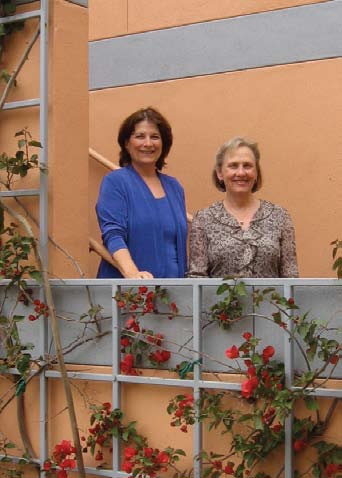 Sarah Vaughan (l) and Monica Curry.
Sarah Vaughan (l) and Monica Curry.
Photo by Charmien Carrier.
Director David Gross is accustomed to explaining the logistics of KITP operations to audiences around the world who wish to emulate it as a retreat facility for scientific research. He said, “When I tell them that the KITP hosts 1,000 visitors a year and that we match 500 of them to a variety of local housing options and that we have one housing coordinator, they are amazed. Our housing coordinator, Monica Curry, is a treasure.”
After eight years working as a real estate agent in the Santa Barbara area, Curry joined the KITP in 1993. “This job is perfect for me,” said Curry, “because it is about relationships.”
The self-described “people-person” recognized the same attribute in Ann and Mike Rice when she first visited them at the home that Ann would later give to the KITP in order to establish an endowment for its newly conceived Family Fund. The relationship between the Rices and Curry evolved over the years into a friendship.
Ironically, the house that turned into the Drs. Ann and Myron Rice Family Fund was itself unsuitable for housing families with young children. Said Curry, “It wasn’t set up for families because of the extensive collection of Western art and figurines. I eyed those pieces and imagined what energetic young children might do to them, so I limited its availability to couples and families with older children.”
Curry similarly assesses each housing unit under her purview (including the most unusual — a cement water tank converted to guest cottage on a ranch in the Foothills) to determine tenant suitability.
“The KITP housing process reminds me,” she said, “of that three-dimensional chess game they used to play on the old Star Trek television series. Moving one piece affects many other pieces on multiple dimensions. I have to take into account the rental provider (when the property is available or not); who is most suitable for the house (kids or not); what transportation options pertain to a property; and, finally, there is the price range."
“Sometimes I have a house and a visitor that don’t quite fit each other,” she said, “but I know no better match is likely, so I have to sell the provider and/or the renter on each other. Then the worst case sometimes happens when that unlikely better arrangement does turn up, and I have to undo my own persuasive message in order to make a better all-around match by moving the first tenant elsewhere to put a more suitable tenant in the initial tenant’s place.”
Curry describes the non-physicist components of her version of three-dimensional chess as follows:
“I have six university apartments and approximately 50 private apartments and condos (although only about 35 or so tend to be available at a given time). Of these, only the university apartments and about six or fewer of the private units are suitable for families; the rest are for couples or singles. I have a roster of about 60 ‘room in a home’ rentals used for single visitors, of which about 40 are used regularly (the rest are a bit far away or are not always available).”
In addition, she said, “I increasingly use resources such as ‘Craigslist’ or online vacation rentals to expand rental inventory when I do not have something suitable for visitors.” According to Curry, “A small handful” of visiting physicists use those same on-line resources to find their own housing accommodations. The rest of the visitors whom she doesn’t house “stay mostly in hotels.”
Asked about the pattern of family use, Curry said, “We previously did not have the ability to note family status in our database, but have recently added this criterion and will be tracking it henceforth.”
Curry said that for the purposes of crafting a proposal for the Family Fund, she and KITP development director Sarah Vaughan worked up “guesstimates” of usage patterns. The number of families visiting three months during the summer has averaged eight to 10, and the number of families visiting five months during the academic year programs has averaged five to eight.
So Curry not only cultivated the relationship that led to the Drs. Ann and Myron Rice Family Fund, but also helped Vaughan envision it beforehand. “Monica is marvelous!” said Vaughan.
